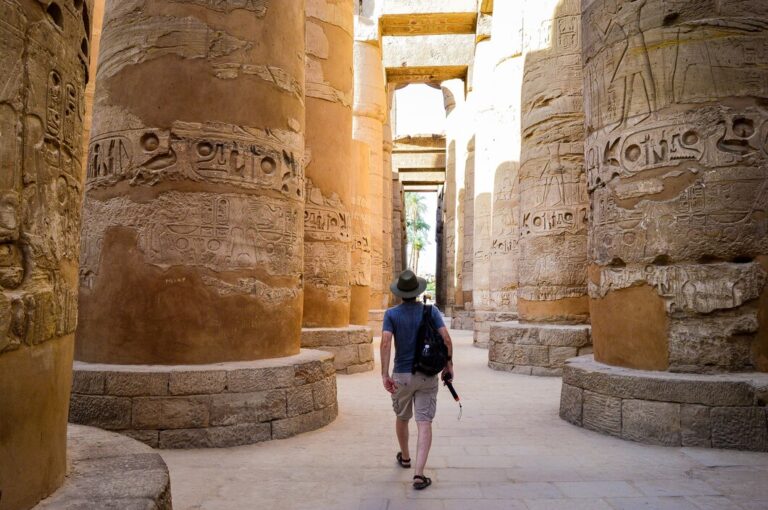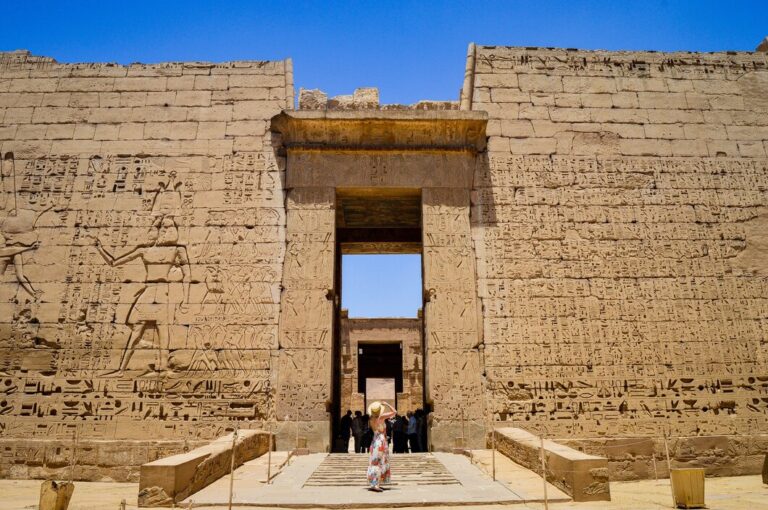Abu Simbel Temple & Statues Of Ramses II In Egypt
The Abu Simbel temples are among Egypt’s most magnificent and enduring monuments, renowned for their colossal statues and intricate artistry. Built by Pharaoh Ramses II in the 13th century BCE, these temples are masterpieces of ancient Egyptian architecture and represent one of the most remarkable feats in the history of monumental construction. Located in Nubia, near the southern border of Egypt, the temples were relocated in the 1960s to avoid flooding from the creation of Lake Nasser. The grandeur of Abu Simbel offers an extraordinary glimpse into the splendor of Ramses II’s reign and the cultural and religious life of ancient Egypt.
The Great Temple of Ramses II
The Great Temple of Ramses II, the larger of the two temples at Abu Simbel, is renowned for its imposing facade and colossal statues of the Pharaoh. The temple is carved into a sandstone cliff and features four colossal seated statues of Ramses II, each approximately 66 feet (20 meters) high. These statues, with their detailed facial features and regal posture, are intended to convey the Pharaoh’s divine authority and eternal power. The temple’s entrance, flanked by these colossal figures, leads into a grand interior with intricately decorated halls and sanctuaries. The most notable feature of the Great Temple is the alignment of its inner sanctuary, which is designed so that twice a year, on February 22 and October 22, the rising sun illuminates the statues of Ramses II, the gods Ra-Horakhty and Amun, and the deified Ramses himself.
The Small Temple of Hathor
The Small Temple of Hathor, dedicated to Ramses II’s chief queen, Nefertari, and the goddess Hathor, is situated a short distance from the Great Temple. This temple is notable for its more intimate scale and the six statues of Ramses II and Nefertari that adorn its facade. The statues, which stand about 33 feet (10 meters) high, depict Ramses II and Nefertari seated together, symbolizing the Pharaoh’s divine rulership and the queen’s revered status. The temple’s interior features beautifully detailed reliefs and inscriptions celebrating Hathor, who was associated with motherhood, fertility, and love, as well as the divine nature of Nefertari.
Relocation and Preservation
In the 1960s, the construction of the Aswan High Dam led to the creation of Lake Nasser, which threatened to submerge the Abu Simbel temples. To preserve these invaluable historical treasures, an international effort spearheaded by UNESCO resulted in the relocation of the temples to higher ground. The temples were carefully dismantled, and each block was reassembled in a new location, approximately 65 meters higher and 200 meters back from the original site. This complex and meticulously executed relocation ensured that the Abu Simbel temples would continue to stand as a testament to Ramses II’s grandeur and the skill of ancient Egyptian architects.
Architectural and Artistic Significance
The architectural design of Abu Simbel is a testament to the advanced engineering and artistic abilities of the ancient Egyptians. The precision in the alignment of the Great Temple’s inner sanctuary, where sunlight illuminates the statues twice a year, reflects an advanced understanding of astronomy and religious symbolism. The detailed carvings and reliefs within the temples depict scenes of Ramses II’s military victories, religious rituals, and offerings to the gods. These artistic elements not only celebrate the Pharaoh’s achievements but also provide valuable insights into the religious and cultural practices of the time.
Visiting Abu Simbel
Visiting Abu Simbel is a profound experience, offering a direct connection to ancient Egypt’s monumental heritage. The temples are accessible by air, road, and cruise ships traveling on Lake Nasser. Due to their remote location, many visitors opt to fly from Aswan, which provides a convenient and efficient means of reaching the site. It is advisable to visit early in the morning or late in the afternoon to avoid the midday heat and to fully appreciate the temples’ grandeur. Guided tours are available and offer valuable insights into the historical and architectural significance of Abu Simbel.
Cultural Impact
The Abu Simbel temples are not only a symbol of Ramses II’s reign but also represent a significant effort in preserving cultural heritage. The successful relocation of the temples was a landmark achievement in international cooperation and cultural preservation. The temples’ status as one of Egypt’s most visited and iconic sites underscores their importance in the collective memory and appreciation of ancient Egyptian civilization.
Conclusion
The Abu Simbel temples, with their colossal statues and intricate carvings, stand as enduring symbols of ancient Egypt’s architectural and artistic prowess. Ramses II’s grand vision and the successful relocation of these temples highlight their cultural and historical significance. A visit to Abu Simbel offers a unique opportunity to witness one of ancient Egypt’s greatest legacies and to gain a deeper understanding of the Pharaoh’s monumental achievements.







